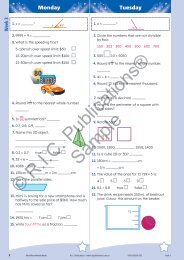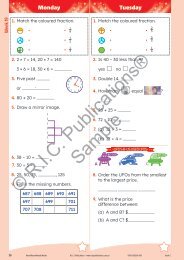RIC-20239 Primary Grammar and Word Study Year 4 – Understanding and choosing words
You also want an ePaper? Increase the reach of your titles
YUMPU automatically turns print PDFs into web optimized ePapers that Google loves.
Underst<strong>and</strong>ing <strong>and</strong><br />
<strong>choosing</strong> <strong>words</strong><br />
Homographs<br />
Focus<br />
Homographs<br />
Definition<br />
• Homographs are <strong>words</strong> that are spelt the same but<br />
have different meanings.<br />
Example:<br />
duck <strong>–</strong> a waterbird with webbed feet<br />
duck <strong>–</strong> a score of zero in cricket<br />
(Note: There are more than these two meanings.)<br />
Sometimes homographs are pronounced differently.<br />
Example:<br />
lead (rhymes with red) <strong>–</strong> a heavy metal used to make<br />
pipes etc.<br />
lead (rhymes with seed) <strong>–</strong> to guide to a specific place<br />
Explanation<br />
• Recognising <strong>and</strong> using different homographs develops<br />
<strong>and</strong> enriches students’ vocabulary. They learn to<br />
underst<strong>and</strong> the meaning of <strong>words</strong> <strong>and</strong> the way they<br />
work in print.<br />
Worksheet information<br />
• As an introduction, give two quiz questions to the<br />
students to demonstrate two different meanings for the<br />
same word. For example; Question 1: What is the name<br />
for a young goat? Question 2: What is a word that means<br />
to trick or tease someone in a nice way? Ask them to<br />
guess the word <strong>and</strong> discuss the different meanings.<br />
Students may suggest other meanings for ‘kid’ such as<br />
a colloquial name for a ‘child’.<br />
• Complete Question 1 on the worksheet <strong>and</strong> discuss the<br />
students’ answers.<br />
• In Question 2, students are given crossword clues for<br />
various homographs. They complete the crossword <strong>and</strong><br />
then write each word (in any order) on the lines below.<br />
Students write another meaning alongside each word<br />
provided. Dictionaries could be used. Again, discuss<br />
students’ answers as there are more than two meanings<br />
for many <strong>words</strong>.<br />
• The word ‘wound’ in Question 3 is an example of a<br />
homograph that has different pronunciations. Discuss<br />
this with the students before they complete the activity.<br />
Discuss their answers.<br />
Ideas for further practice<br />
• Students compile a class homograph dictionary by<br />
brainstorming to list a specific number of <strong>words</strong> <strong>and</strong><br />
arrange them in alphabetical order. A word can be<br />
written at the top of a page with two or more definitions<br />
underneath.<br />
• Students identify homographs that have different<br />
pronunciations <strong>and</strong> compile a class reference chart.<br />
Suggestions include: tear (rhymes with queer)/tear<br />
(rhymes with bare); wind (rhymes with pinned)/wind<br />
(rhymes with fined); bow (rhymes with flow)/bow<br />
(rhymes with cow).<br />
Answers<br />
1. (a) Possible answer: A sentence that explains a<br />
device with prongs.<br />
(b) Possible answer: A sentence that explains to carry<br />
or support something.<br />
2. (a)<br />
1<br />
M<br />
2<br />
B O L T<br />
3<br />
G U<br />
R S<br />
4<br />
B O X E R<br />
U<br />
5<br />
C O R N<br />
A<br />
D<br />
6<br />
S E A L<br />
F<br />
(b) Possible answers for other meanings than the<br />
homophones in the crossword:<br />
bolt: to dart off suddenly<br />
boxer: a breed of dog<br />
corn: a painful lump that can form on the toes or<br />
foot<br />
seal: to close something so it can only be opened<br />
by breaking the ‘seal’<br />
©R.I.C. Publications<br />
Low Resolution Images<br />
Display Copy<br />
mouse: a device attached to a computer for<br />
controlling the curser<br />
ground: the top layer of the surface of the Earth<br />
calf: a part of the lower leg<br />
3. (a) wound (rhymes with tuned): a sore such as a cut<br />
or burn<br />
(b) wound (rhymes with found): past tense of the verb<br />
‘to wind’<br />
<strong>Primary</strong> grammar <strong>and</strong> word study 34<br />
www.ricpublications.com.au R.I.C. Publications ®


















